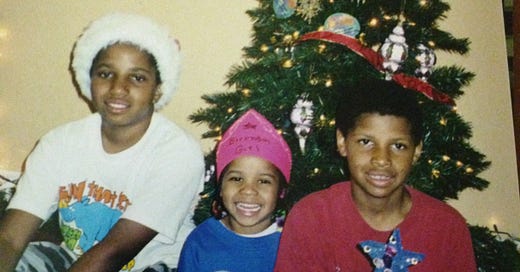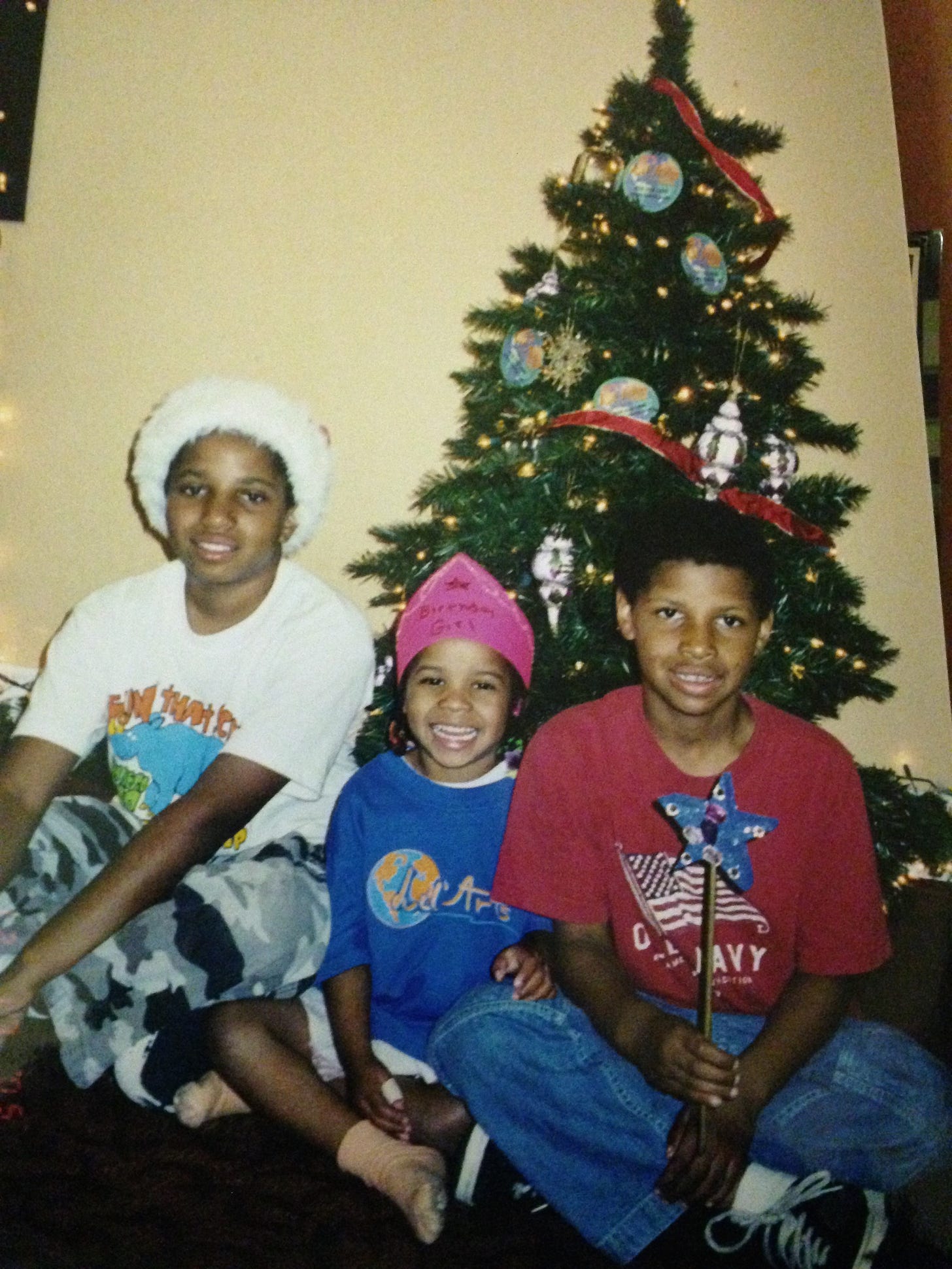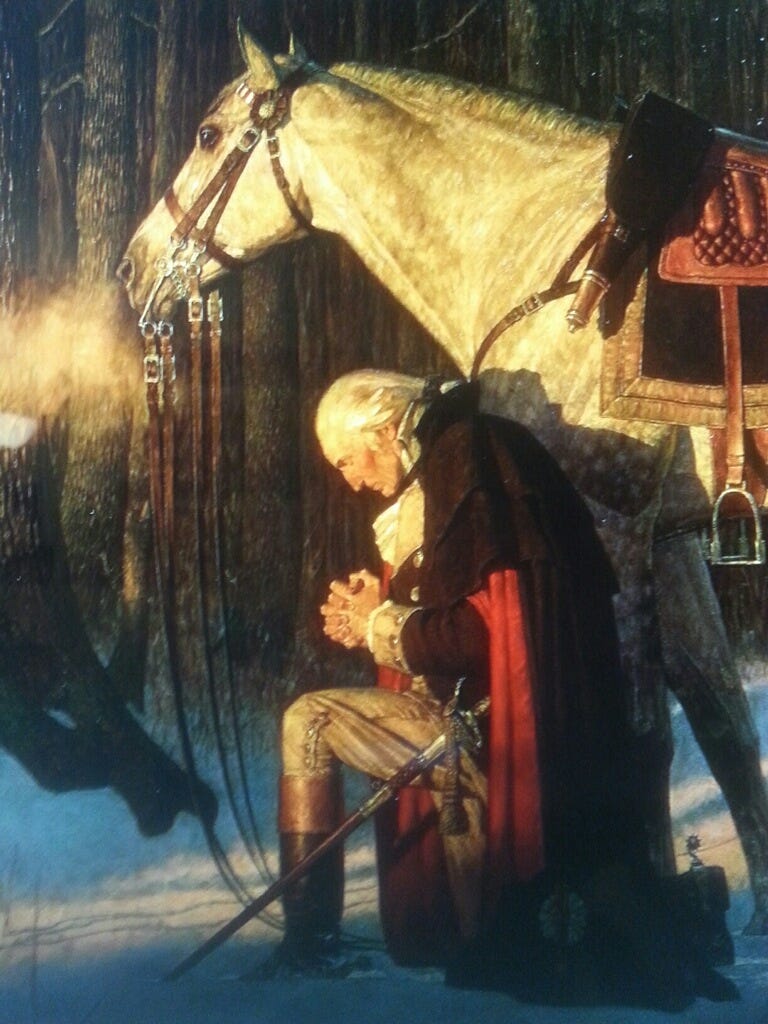Vivacious Beloved Cousin
“What is it, Winkfield? Did you discover who owned us?” With just enough sashay to dilute the sting, Beloved Cousin nailed it. Beloved Cousin and I had grown up on Twyman Road. She lived down at the end of the road on Rosa Nell Lane named after our Grandma. I loved Beloved Cousin more than my own sister. Beloved Cousin had a Twyman way about her. Never shy to speak her mind and quick with the quip, Beloved Cousin lived on the razor’s edge of anxiety. The combination of outspokenness, quick wit, and suppressed worry had enthralled me since elementary school. Her brother served as Best Man in my wedding.
I sidestepped Beloved Cousin’s putdown and retold how we Twymans were all related to George Twyman III from Albemarle County. Before she could engage me, another family member interrupted Beloved Cousin at dinner. The matter passed between us. As dinner concluded, Beloved Cousin asked me out to dinner that Friday when I returned to Chesterfield. I accepted because I enjoyed Beloved Cousin’s company. I also knew she wanted to sound me out on race. Sadly, race lingered in the air.
I had barely settled into the front passenger seat of a young cousin’s car with Beloved Cousin before the flood gates burst. “I’ve been meaning to ask you, what do you think of Black Lives Matter?” The look on Beloved Cousin’s face revealed classic Beloved Cousin. She could barely contain herself at the prospect of hearing some zany position from her Cousin. I did not disappoint. I said I found Black Lives Matter mildly offensive. Black Lives had always mattered to me. I didn’t need a faux movement to tell me what I knew from day one. Beloved Cousin offered all of the standard tropes like police brutality, victimized black men and whatnot. I wasn’t having it but we knew each other well enough to enjoy the disagreement.
Over an Indian dinner in Carytown, Beloved Cousin and I continued our race talk. “You live in a Bubble. You don’t understand what it’s like out there,” Beloved Cousin charged. She wanted me to see the world as she saw it. I felt like saying she lived in a Bubble since the world was larger than Chesterfield and Richmond. The world weighed in at half of one-percent African-American. If you viewed the world only through the lens of African-Americans, you would be missing out on the other 99.5% of what the world has to offer. I felt like saying I had never had any untoward experiences with the police that were not of my own making. Black Lives Matter distracted from the more important work of education and self-worth. It mattered far more that a niece choose the Governor’s School for the Gifted over an underperforming neighborhood school, the opportunity to attend an elite New England boarding school (all expenses paid) over a failing public school, the mindset that no one had more power over my niece’s destiny than my niece.
To administer the coup de grace, Beloved Cousin shared with emotion the obligatory tale of prejudice. When she was in elementary school, a white teacher brought the only three black kids in the class up to the front. The teacher asked the first black kid to say where the books were kept. He said, “Liberry.” She asked the second black kid to say where the books were kept. He said, “Liberry.” The teacher turned to Beloved Cousin and asked the same question. Beloved Cousin said, “Library.” The teacher turned to the class and said, Beloved Cousin said it like a white person. “Don’t you know that haunted me through school?” What Beloved Cousin did is so typical when race is discussed within families. She presented an emotional (and despicable) example of prejudice as an indictment of the universe. How could Beloved Cousin ever achieve and succeed in life if some random white teacher on some random day made a single prejudiced remark? This is how Beloved Cousin understands the world.
I took a different lesson from Beloved Cousin’s story: Whatever happened to resilience in the face of adversity? If our ancestor, Daniel Brown, could rise from slavery, overcome innumerable obstacles, and acquire hundreds of acres after the Civil War, surely Daniel Brown’s great great granddaughter, Beloved Cousin, could navigate an ignorant remark in the 1970s in a desegregated public school.
Even Beloved Cousin began to grow weary of race talk. With her haunting Virginia accent, she summed up her case with a single question: “What I want to know is what have you done to help the community? That’s what I want to know.”
As a writer, I’m not quick on the snappy comeback like Beloved Cousin. I take my time to think about things and let insights bubble up to the surface. The more I thought about Beloved Cousin’s challenge, the more the answer came to me. Consider the power of history with this simple thought experiment. Here are two photos of three Black American children. Each photo is identical, save for a different caption. Both captions are true.
These three children are the descendants of Bamoun, Igbo and Hausa peoples who were enslaved on Virginia plantations.
What is your perception of these kids? Do you feel curious about them? Do you want to know more about them? Do you feel more or less a connection after reading this caption? Are you drawn to them? What might be their self-image?
These three children are the descendants of George Twyman III, Colonel Richard Lee I, and distant second cousins of President George Washington.
Has your perception of these kids changed? How so? Do you feel curious about them? Do you want to know more about them? Do you feel more or less a connection after reading this caption? Are you drawn to them? What might be their self-image?
We may never know the mental harm of missing genetic ancestors. Slavery orphaned all descendants of slaves. We are blessed to live in an age when a motivated Black American can reach back into time and complete their genetic puzzle. If nothing else, learning objective truths about family history should change perspectives. As my daughter now studies Advanced Placement European History, she will recognize names that are part of her genetic self. She will feel a closer connection to the subject matter, even if she resists a bond for the sake of appearances. Susan, one of our family friends from The Child’s Primary School in San Diego, believes knowledge of family connection creates a visceral, primitive attachment. When my daughter holds a dollar bill or passes the exit for Washington Street or sees the Washington Monument on television, might she feel something she never felt before, pietas. My Beloved Cousin would probably want me to tutor inner-city children or march in the streets to show I have helped the community. I’m not that guy. I am a guy who believes historical truths can transform my children on the inside. This is one small way in which I have helped my family better know their past, even though my oldest son and daughter cannot see beyond slaveholding. And isn’t truth about oneself one small step for my daughter, one giant leap for the community’s sense of self?
This is as good a time as any to discuss the greatest threat to a healthy black culture and consciousness—an inability to see beyond slaveholding. If we never move on from slavery in our lives, what price do we pay today? Dwelling on past resentments does nothing except create a permanent state of grievance against Shelby, Winthrop and other white descendants of slaveholders, our blood cousins. How is this healthy? Even our slave ancestors like Charlotte would want her descendants of slaves to move on. We honor Charlotte by living up to the words of Nelson Mandela—“Resentment is like drinking poison and waiting for your enemy to die.”
_____
Truth & Reconciliation
The greatest poison in the Hunt for Distant Family is not the random white supremacist. White supremacists are moral neighbors of sex predators and mass murderers. They horrify us because they are outliers. And as outliers, they are irrelevant to our search for truth and reconciliation.
The seemingly insurmountable mountain to be overcome is negative thinking about others of another race. A family member exemplifies the power of negative thinking on race. Any conversation longer than five minutes invariably descends to race. When recalling a conversation with a public official, she latches upon the man’s inadvertent use of “changing the complexion of the legislature” as a micro aggression. She takes satisfaction in forcing the man to back away from, and apologize for, any offense that might have been taken. Isn’t life too short to micromanage the good faith words of others?
As I shared my Hunt for Distant Family with this family member, she seemed strained and ill-at-ease. I guess she doesn’t dig mixed families. I dreamed about meeting Shelby, Winthrop and Victoria one day and sharing tales about our mutual journey of discovery. My family member zeroed in on the negative and warned that I should be careful about meeting my white cousin in Kentucky. My daughter sat within earshot, so the family member nicely modeled unthinking fear of the unknown. Not content to just allow the fear to simmer, my accomplished family member wiped out a website on her cell phone showing the locations of all hate crimes in the country within the past year or two. Who does that? Who is so fixated on fear that one carries around a bookmark to hate crimes? I bookmark stock charts. I bookmark inspirational messages from alumni of Harvard Business School. But hate crimes? My family member only feels comfortable with fear in the world. And this fear of the unknown is her deliberate legacy to my daughter.
As I described the wonderful cousins I had found in my Hunt (Sam, Shelby, Victoria, Winthrop), my family member kept asking about race. She didn’t ask about their gender. She didn’t ask about their city. But she needed to know their race. Only race enabled my family member to keep the players straight and make sense of a Hunt for Distant Family. That is sad, and depressing. It is the poison that most endangers the Hunt for Distant Family.
The media will never spend days of air time focusing on the root causes of divisions. It is easier to flame fear with the boogeyman of white supremacy. What we should fear more is the family face of prejudice. The greatest poison in my Hunt for Distant Family has not come from the outside. The greatest poison has come from inside my home.
As the sun rose this morning, I began to ponder one of life’s greatest questions—Is White Supremacy a Thing Today? The question haunted me while I showered. Before I was dressed, I resolved to Hunt for White Supremacy today. I ran downstairs excited about my day’s mission only to be sidestepped by my daughter’s forlorn expression. “Dad, school is so hard,” she said. I sat down on her rocking chair and didn’t think twice. “Look, in ten years, you’ll going to come see me in my rocking chair. You’re going to say how thankful you are that I enrolled you at __________. You will hug me and say College was a breeze compared to high school.” My fourteen-year-old daughter rolled her eyes at me and smiled a Twyman smile. I offered to take her to Starbucks before the library at the University of San Diego (USD). She readily agreed.
Mindful that I was searching for White Supremacy, I didn’t want to bias my findings. I chose my silver car over the white car. A little reverse discrimination. See how that works? On the car ride to Starbucks, I asked my daughter about her studies. She said, with great resignation, that she had to study AP Euro History, Spanish, Chemistry and English. As I drove, I wondered whether we would face White Supremacy at Starbucks. I primed myself for the slightest micro aggression. Nothing. No Whites Only signs greeted us. No white bigots cut in line in front of us. The barista offered pleasant service, no slurs or hate speech to be had. All of the customers ignored us as they were engrossed in their work, cell phones or each other. There was no White Supremacy here.
I had hopes for the ride from Starbucks to USD. The drive was a few miles and there was ample opportunity to experience Driving While Black. Sadly, there were no cops to be seen. I looked and looked. Nothing. As we pulled into USD, we saw worshipers leaving a mass service. Now, if White Supremacy were a Thing today, my daughter and I would have to suffer the unexpected n-word, the random slur that we return to Africa from whence we came. (Ironically, my Native American ancestors from 12,600 years ago might have something to say about our family’s deepest of roots in North America.) I waited and waited. Nothing. I did see people enjoying life on a Sunday morning. I saw families creating memories together. I joked with my daughter that, one day, I would be driving her kids to study at USD. She quickly corrected me. She would be living in La Jolla, so I wouldn’t be creating this tradition with her kids. Her face bespoke OMG!
As we walked to the library, my daughter strained her neck to look at a parked Telsa. I get no thrill from cars I cannot afford. My daughter remarked that USD was “a pretty campus” as two small kids played tag, you’re it, outside the library steps. Prominent at the entry to the library was a sign trumpeting “It’s Time to Interact. Use your voice to put an end to sexual violence.” I turned my head towards the left and took in endless blue sky with the Pacific Ocean in the distance. Cool breezes caressed my arm. The temperature was 73 degrees. If Colin Kaepernick was right, oppression waited for me in the wings. I breathed with anticipation waiting, waiting for the rogue cop to run up the steps of Copley Library and handcuff me. Or, maybe oppression would appear as a monster, the devil himself, a white male. I waited and waited for evil.
Look there. Yes. I do declare. A white male. I smiled. He was enthralled in his own world on his cell phone. I took note of his backwards cap. I listened intently for the first words of hate….I waited. I wasn’t hearing oppression. He was wasting time with one of his bros. I saw another white male. Nothing. He didn’t see us as he headed into the library. College is for study, you know, not perpetual protest.
I was disappointed. Was Kaepernick wrong?
A mixed-race kid walked by.
As I entered the library and turned to the right, I saw a shrine to the Patron Saint of All Things Racial, Ta-Nehisi Coates. (I would love to know if “Ta-Nehisi” is a family name and for how many generations “Ta-Nehisi” has graced the Coates line.) Between the World and Me is prominently displayed along with all things negative about the Black Experience. I kid you not. There is a book titled Race and Social Justice. (How about Race and Black Achievement?) Not to be outdone, the next book is titled African-American Males and the U.S. Justice System of Marginalization: A National Tragedy. Filling out the bench of gloom and doom ruminations would be Race and Justice: Wrongful Convictions of African American Men, Black Lives Matter to Black Liberation, and Against the Wall: Poor, Young, Black and Male. Heaven help us! If I had internalized this junk as a youngster, I would have been a goner. (This leads me to another Thing, The Great Abdication by Black Law Professors, which I will publish at a later date.)
I could write a treatise on the everlasting harm of Coates but my time is limited and this email is about overcoming divisions. Suffice it to say few writers have ruined the spirit of African-Americans more than Coates. He will have much to atone for when history is written.
[To be continued….]







Another interesting writing about our families and how we interact with each other in the light of our race…